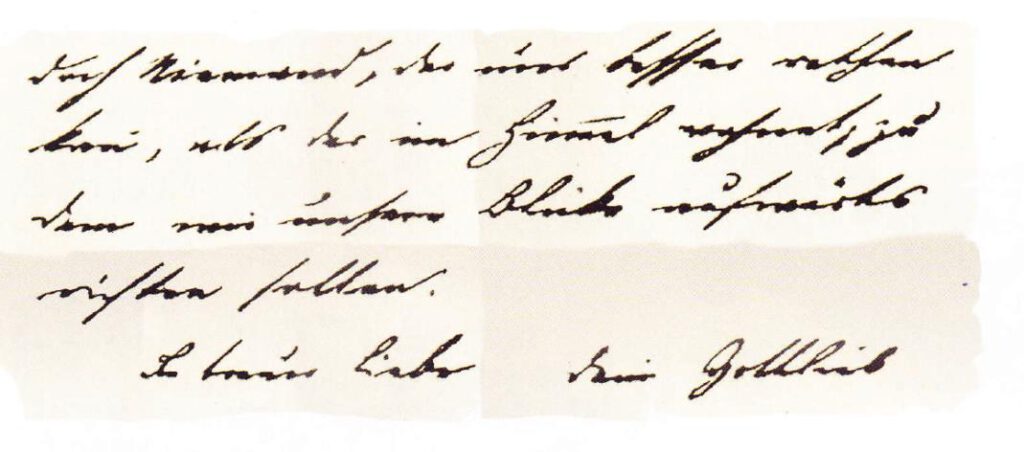IN THE FOOTSTEPS OF GOTTLIEB DAIMLER
PIONEER OF AUTOMOTIVE ENGINEERING
The year was 1886, and a new invention was about to change the world. Gottlieb Daimler, born in the tranquil town of Schorndorf, presented for the first time a moving car without horses – his “motor carriage” with the high-speed gasoline engine he had invented. This motor carriage is considered the world’s first four-wheeled automobile. Together with Carl Benz, who designed a three-wheeled motor carriage at the same time, Daimler and Benz are considered the pioneers of automobile construction at the end of the 19th century.
The following sections focus on the life of Gottlieb Daimler. In particular, his religious environment, his relationship to the Christian faith, and his revolutionary inventions as a pioneer of the automobile are considered.
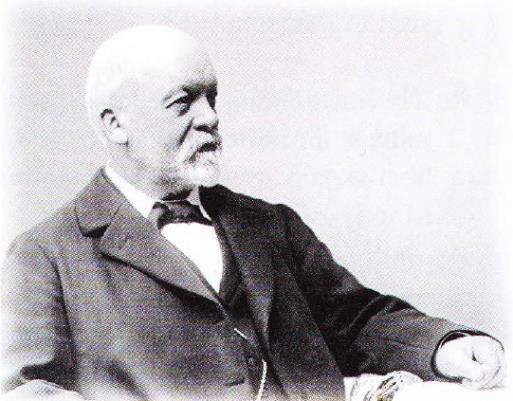
Gottlieb Daimler, 1834 - 1900
BIBLE VERSE OF HIS CONFIRMATION
‘Stay with what you have learned and what is entrusted to you.’
2 Tim. 3:14
Gottlieb Daimler grew up in a pietistic home in Schorndorf. In the spring of 1848 he was confirmed in the Schorndorf town church. As saying of his confirmation he was given the Bible verse from 2 Tim. 3:14.1 In the verses 16 and 17 it goes on to say: ‘All scripture is given by inspiration of God, and is profitable for doctrine, for reproof, for correction, for instruction in righteousness: That the man of God may be perfect, throughly furnished unto all good works.’
LIFE BETWEEN PIETISM AND LIBERAL THEOLOGY
The fact that ‘the scripture is God-given’ was vehemently opposed by liberal theologians at the time of the young Daimler. Above all, it was David Friedrich Strauss, who propagated in 1835 with his book ‘The Life of Jesus’ the demythologization of the Bible and the history of salvation. This two-volume work with more than 1,400-pages was ‘like a terrible earthquake’ across Europe and was described by critics as ‘the most corrupt book’ that ‘hell ever spit out of its throat’.2
While within the church and at the universities in the time of the young Daimlers it was considered chic and scientific to question the divine origin of the Bible, in Schorndorf Pietism shaped civil and ecclesiastical life.3 The former Special Superintendent (today Dean) of Schorndorf, Friedrich August Baur, noted in his visitation reports: ‘Pietism is of importance in scope and influence, it is a decisive force for the bourgeois and ecclesiastical community’. Even the young Daimler knew the Pietist ‘hour people’, attended their weekly meetings 200 citizens (with a city population of 4,000 at that time).
HIS CHILDREN ATTEND PIETISTIC SCHOOL
Impressed by the diligence and conscience of his pious compatriots, Daimler later entrusted the education of his daughters to pietistic institutions. It was important to him ‘that every one of his children should be religiously educated and participate in church services and church celebrations’.4
At that time, the Pietist schools were a sure wall of protection against the corrosive influences of modern theology that human reason set over God. The daughters of Daimler were housed in the pietistic boarding school in Königsfeld in the Black Forest.
HIS REFERENCE TO CHRISTIAN FAITH
The spiritual attitude of his parents’ house, in which Daimler grew up, becomes visible in what his grandmother Wilhelmine (died July 9, 1875) had once left on books: two hymnals, a Bible and a ‘Paradiesgärtlein’ (famous painting from about 1410 by an unrecognized painter from the Upper Rhine), two sermon books and three prayer books written by various Pietist ministers.
We do not know which spiritual impulses Gottlieb Daimler took from his hometown Schorndorf into the ‘wide world’. His work and studies took him to France and England. Violent disappointments with important business partners were not spared him. In the midst of a critical situation in his life, he wrote to his wife Emma on March 15, 1872:
HIS BIRTHHOUSE
The Daimlers have been master bakers for generations. Since 1787 at the latest, the Daimlers’ bakery has been located at number 7 in Höllgasse, the “Bright Alley”. In 1825, Johannes Deumler, Gottlieb’s father, took over the business, which in the meantime also included a wine tavern. His marriage to the dyer’s daughter Wilhelmine Friederike Fensterer produced four sons: Johannes (1832), Gottlieb Wilhelm (1834), Karl Wilhelm (1840) and Christian Albrecht (1845). Daimler’s father did not become rich from the bread and wine trade. Nevertheless, he gave the young Gottlieb a solid education, first at the local Latin school and then in Stuttgart at the Royal State Trade School. Gottlieb Daimler learned his craft from a gunsmith; his journeyman’s piece was a double-barreled, elaborately decorated pistol.
In 1853, Daimler left Schorndorf, which at the time had a population of around 4,000, and returned only rarely. Ferdinand Steinbeis, promoter of industrialization in Württemberg, had become aware of him and arranged for him to work as an industrial worker in Graffenstaden near Strasbourg in preparation for the Polytechnic School in Stuttgart. The business in the Höllgasse was run by his brothers Johannes and Karl Wilhelm. Due to the poor earnings situation, Karl Wilhelm’s widow sold the house in 1897.
Gottlieb Daimler’s notebook from his trip to Russia in 1881 shows a sensitive observer and artistically educated person. His extensive travels and the limited possibilities of transport finally led Daimler to his world-changing vision: ‘The overcrowding of trains during summer travel and the constraints of the railroads were repugnant to me and led to the idea of self-operated driving, etc.’5

Gottlieb Daimler′s birthplace in Schorndorf (Württemberg)
WORLD’S FIRST FOUR-WHEELED AUTOMOBILE
On March 8, 1886 Gottlieb Daimler ordered a carriage in the version ‘Americaine’ from the coach builder Wilhelm Wimpff & Sohn, ostensibly as a present for his wife Emma’s forthcoming birthday, but in reality to equip it with an engine as a further test vehicle. The engine was an air-cooled, upright single-cylinder modelled on the ‘grandfather clock’, which had already been used in the two-wheeled ‘riding car’. The term ‘grandfather clock’ was used by Gottlieb Daimler and Wilhelm Maybach for their high-speed four-stroke engine, developed and patented in 1885, because it was reminiscent of a pendulum clock. Compared with the engine from the ‘riding car’, Daimler and Maybach had almost doubled the cubic capacity of the motorized carriage, thus allowing the performance to be raised to 1.1 hp.
Daimler’s motor vehicle was the first four-wheeled vehicle to driven by a high-speed combustion engine. In contrast to the Benz Patent Motor Car, which represented an independent integrated construction, Daimler’s first automobile was merely a carriage without shaft and with the common fifth-wheel-steering – a carriage without horses so-to-speak.
For the time being Daimler did not think of an evolution model or even the series production of his motor vehicle. With the motor carriage he once again had demonstrated the possible ways of using his engine and carried on to pursue the goal of producing engines for all conceivable industrial applications.6
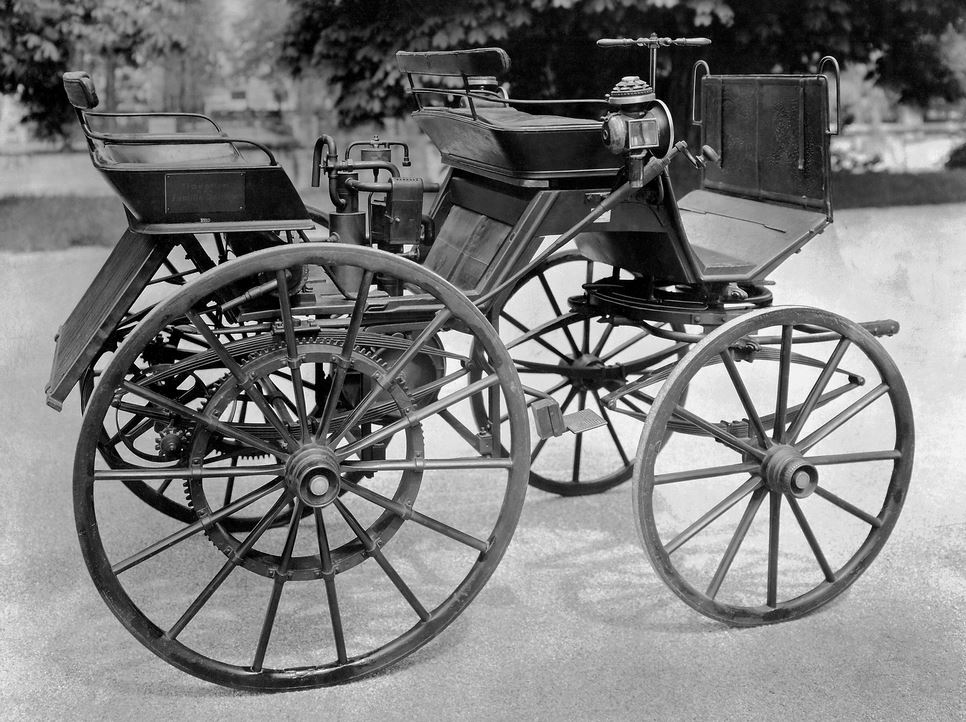
Daimler motor carriage, 1886 © Daimler AG
FIRST DAIMLER TRUCK
One of Gottlieb Daimler’s greatest, most overlooked talents was to keep finding new applications for his engines. It began with a motorcycle, and continued with marine engines, automobiles, pumps for fire engines, and motorized trolleys. From Daimler’s point of view, it was only logical to use engine power to transport loads as well.7
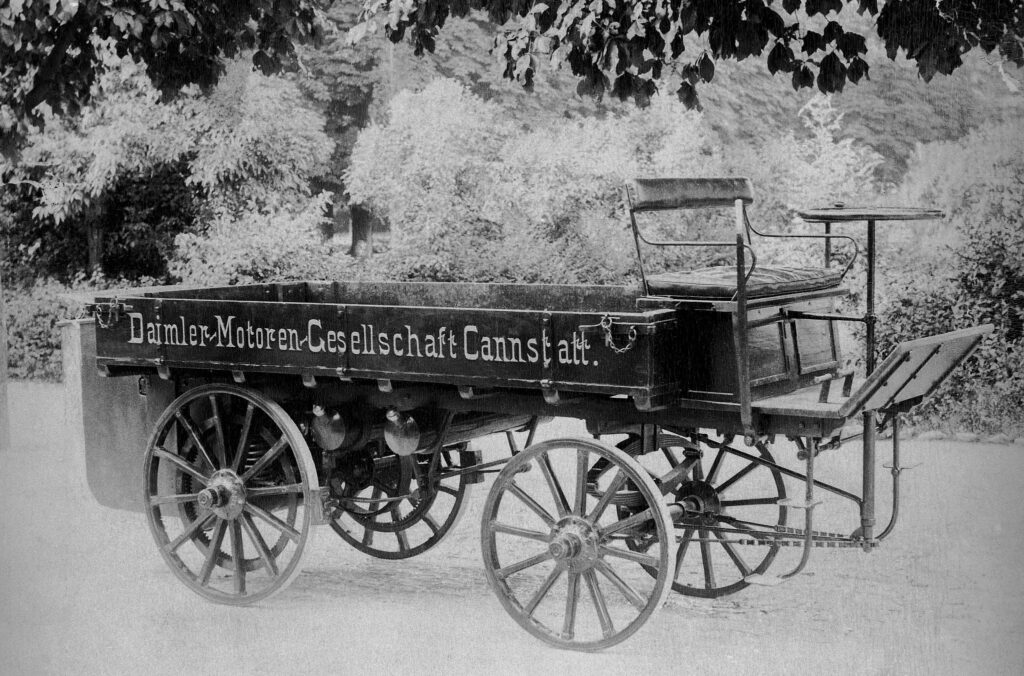
The first Daimler truck, 1896 © Daimler AG
On August 18, 1896, Gottlieb Daimler presented the first gasoline-powered truck. However, it initially found no takers. It is known that in 1897 Daimler advertised his truck at the annual Württemberg agricultural exhibition held in the fall. Remarkably, he played down the aspect of the fundamentally new technology and put his invention on a par with conventional draft animals. Thus, the text of the handout distributed at the Cannstatt Folk Festival in 1897 read as follows7:
A ‘Daimler’ is a good animal,
Pulls like an ox, you see it here,
It eats nothing when it stands in the stable,
And drinks only when there’s work to be done;
It also threshes and saws and pumps for you,
If you lack money, which is often the custom;
It will not get foot nor mouth disease,
And doesn’t play a stupid trick.
It does not take you angrily on the horn,
Therefore buy only such an animal,
Then you are provided forever.
Note: In the original German version, the verses rhyme.
GOTTLIEB DAIMLER AND CARL BENZ
The two inventors Gottlieb Daimler and Carl Benz knew about each other and had apparently fought patent disputes with each other at the end of the 19th century – but, according to reports, they never met in person throughout their lives.
For a long time, they were simply competitors of two highly successful companies, especially in the period immediately before the First World War, and yet they had completely different objectives. For a long time, Daimler was concerned with the construction of an engine that could be used in a variety of ways and was initially built into a two-wheeled wooden frame – the so called ‘riding car’ (as the forerunner of the motorcycle). Later also in a carriage, and in a boat. Carl Benz aimed from the outset at the invention of the automobile, as a unit consisting of engine and chassis. However, both initially earned their money primarily by building stationary engines – for industrial use.
Gottlieb Daimler is considered to be the more well-traveled and versatile designer, company director and industrialist of the two. After studying mechanical engineering, the baker’s son had undertaken several years of study trips to France and England, first worked in a metal goods factory in Geislingen (as the forerunner of today’s WMF), was head of the workshops of the Karlsruhe Maschinenbaugesellschaft (for three years) and the Deutz gas engine factory in Cologne (for ten years). In 1882, he founded an experimental workshop in Bad Cannstatt, and the following year he was awarded his first patent – at the age of 49 at the time.
This was followed by the development of the ‘riding car’ – a motorcycle on a wooden frame. Daimler then commissioned Maybach, who remained associated with him throughout his life, to design a motor car. Sales of the vehicles remained unprofitable – in 1890 the Daimler-Motorengesellschaft was additionally founded, which as ‘DMG’ was later to become the basis of Daimler’s global success, and the merger counterpart with Benz’s company. In 1899, one year before his death (at the age of 66), the construction of Wilhelm Maybach’s racing car began, which was to bear the name ‘Mercedes’, and be 86 km/h fast.
Born in 1844, Carl Friedrich Benz, the son of a locomotive driver – and ten years younger than his later competitor Daimler – had studied mechanical engineering in Karlsruhe. He gained his first experience in locomotive and vehicle construction and also in bridge building. Immediately after graduating, he moved to Pforzheim, and later to Mannheim. In 1871, he founded an iron foundry and a mechanical workshop there – together with a partner. Right from the start, he worked on plans for a self-propelled, trackless vehicle. The survival of the company was ensured (not least) by the contribution of the dowry of his fiancée Bertha Ringer. This was not the case with Daimler, who had received extensive share packages when he left the Deutz company in Cologne and was thus able to finance his inventive drive.
In 1880, the first engine developed by Benz himself was ready for operation, and he founded a joint stock company in which he himself held a five percent stake. After disputes, he left the company in 1883 and founded the new ‘Benz & Cie. Rheinische Gasmotorenfabrik’ in Mannheim, as an AG – the later merger part to the Daimler-Motorengesellschaft, the DMG. In 1885, the first automobile built by Benz was in working order. On January 29 of the following year – Benz was 42 years old at the time – he patented the self-propelled three-wheeled vehicle for the ‘German Reich’.8
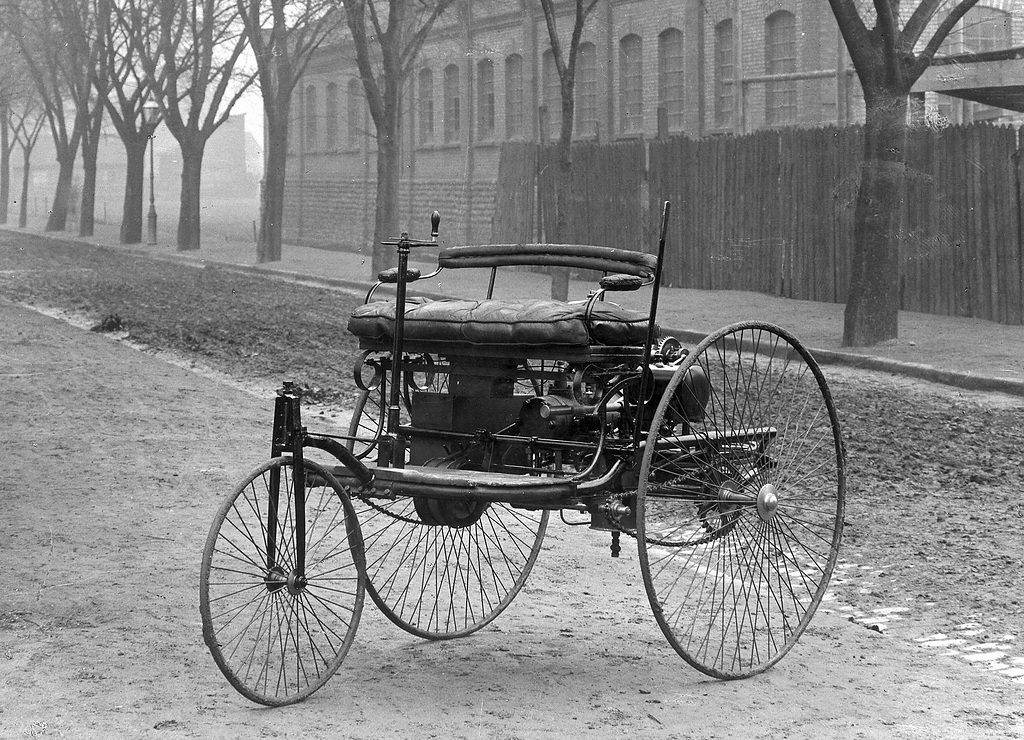
Benz Patent Motor Car, 1886 © Daimler AG
HIS TOMBSTONE
On March 6, 1900, Gottlieb Daimler died in Bad Cannstatt near Stuttgart and was buried there on the Uff churchyard. His tombstone contains the engraved lettering ‘Psalm 37, 6’.
The verses 1-7 of Psalm 37 read:
‘Don’t be upset because of sinful people. Don’t be jealous of those who do wrong. Like grass, they will soon dry up. Like green plants, they will soon die. Trust in the Lord and do good. Then you will live in the land and enjoy its food. Find your delight in the Lord. Then he will give you everything your heart really wants. Commit your life to the Lord. Here is what he will do if you trust in him. He will make your godly ways shine like the dawn. He will make your honest life shine like the sun at noon. Be still. Be patient. Wait for the Lord to act. Don’t be upset when other people succeed. Don’t be upset when they carry out their evil plans.’
DAIMLER’S CURRICULUM VITAE
Gottlieb Wilhelm Daimler, 1834 to 1900 5
• 1834 Born in Schorndorf on March 17
• 1848-1852 Apprenticeship with a gunsmith
• 1853-1857 Practical training in mechanical engineering in Graffenstaden in Alsace
• 1857-1859 Training in mechanical engineering at the Polytechnic School in Stuttgart
• 1859 Return to Graffenstaden in the old position
• 1861-1863 Stay abroad in England, employment at the Straub machine factory in Geislingen
• End of 1863 Technical manager of the Bruderhaus machine factory in Reutlingen
• 1867 Marriage to Emma Kurtz
• Dec. 1868 Workshop manager of the ‘Maschinenbaugesellschaft Carlsruhe’
• 1872 Technical manager of the Deutz gas engine factory
• Sept. to Dec. 1881 Trip to Russia on behalf of the Deutz company
• 1882 Leaves the Deutz gas engine factory, moves to Cannstatt and starts work in the garden house of his villa
• 1883 The first high-speed engine runs
• 1885 The second engine, the ‘grandfather clock’, is granted the German Reich patent DRP 34926. First outing with the ‘Reitwagen’, the world’s first motorcycle
• 1887 Engine production at the Seelberg factory
• 1889 Two-cylinder V-engine, steel-wheeled car and four-speed gearbox. Death of Emma Daimler
• 1890 Foundation of Daimler-Motoren-Gesellschaft (DMG)
• 1890-1894 Deputy member of the Supervisory Board of DMG
• 1892 Collaboration with Wilhelm Maybach at the Hotel Hermann
• 1893 Marriage to his second wife Lina Hartmann
• 1894 Separation from DMG
• 1895 Rejoins DMG, Chairman of the Supervisory Board
• 1900 Gottlieb Daimler dies in Bad Cannstatt on March 6
REFERENCES
Much of the content on this page is taken from the article ‘Das Wort Gottes im religiösen Umfeld von Gottlieb Daimler’ by Martin Landmesser, which was published in 2013 in the newsletter of the ‘Evangelische Karmelmission e.V.’ (Protestant Carmel Mission) in issue 01/13. There again, reference is made to the following sources:
1 Rolf Scheffbuch: ‚Pietismus an Rems und Murr‘. Lecture given on May 17, 1990 – published in: Series ‚Typisch im Rems-Murr-Kreis – Wissenswertes über Struktur, Wirtschaft, Kultur und Geschichte‘, Waiblingen 1990; Paul Siebertz: Gottlieb Daimler, ein Revolutionär der Technik, p. 292, Stuttgart 1950.
2 The Christian Spectator, Bd. VII, p. 367, London 1866.
3 Landeskirchliches Archiv Stuttgart, A29-4082 (cited by Rolf Scheffbuch: Das kirchliche Schorndorf um die Mitte des 19. Jahrhunderts – A contribution to the Daimler commemorative year 1984, Schorndorf 1984).
4 Paul Siebertz: Gottlieb Daimler, ein Revolutionär der Technik, p. 301, Stuttgart 1950.
Additional sources:
5 Markus Jordan: ‘Das Gottlieb-Daimler Geburtshaus steht 26 km östlich von Stuttgart’, MBpassion, March 2, 2020, https://blog.mercedes-benz-passion.com.
6 Daimler Media Database: ‘Daimler Motor Carriage, 1886’, https://mercedes-benz-publicarchive.com.
7 Daimler Media Database: ‘Wie Daimler und Benz den motorisierten Transport auf den Weg bringen’, December 4, 2008, https://media.daimler.com.
8 Stefan Jehle: ‘Benz und Daimler: Die badisch-württembergische Fusion’, Landeszentrale für politische Bildung Baden Württemberg, https://www.landeskunde-baden-wuerttemberg.de.
